CITIES change. They grow, decay, stagnate, thrive. Rivers alter their course. Plagues lay waste to populations. Conquerors ravage the countryside, cutting off food supplies.
But as humanity expands relentlessly, more and more people migrate from the hinterland into growing urban areas. Here, life is less harsh, and there are more possibilities. Even after they discover that the streets aren’t paved with gold, the newcomers know they are making this sacrifice for the next generation.
Old residents often grumble at the influx of what they consider to be uncouth outsiders, but forget that much of modern Karachi has been built by Pakhtun labourers. In fact, the MQM, the city’s nemesis, came into being partly due to tensions in the city between the Mohajir and the Pakhtun communities in the 1980s.
A little over a decade earlier, the Mohajirs and Sindhis had engaged in deadly clashes over Bhutto’s language reforms that made Sindhi the official language in the province. Urdu-speaking people saw this move as directed against their community as it placed them at a disadvantage in government service.
Much of Karachi’s planning was handed over to corrupt elements.
At Partition, the city had a population of around 400,000. This exploded when waves of Indian Muslims migrated to the capital of the freshly baked state of Pakistan. Most of them arrived with just the clothes they were wearing. Today, Karachi has a population of anywhere between 17 million and 20m, depending on who’s counting.
Our family was more fortunate than most as my father was a civil servant, and we had housing allotted for us when we reached Karachi on Aug 14, 1947. I was only three then, and have no memory of those events. I was told by my mother that our train had been attacked by a group of armed Sikhs. As luck would have it, soldiers had been sent to escort us, and they beat back the attack.
The Karachi I grew up in was small, clean, and well-run. School was less than a mile away, and we often walked there and back. My father would walk with colleagues to the Federal Secretariat, a bit over a mile from home. There was little traffic, and certainly no danger of kidnapping.
Although there was a steady increase in the city’s population, I don’t recall the kind of concrete jungle it has become today. I think it was the oil boom that triggered the helter-skelter rush towards Pakistan’s only port city. When Arab countries unleashed their ban on exports to Western countries following Israel’s victory in the 1973 war, oil prices shot up and desert countries found themselves knee-deep in petro-dollars.
That was when Bhutto negotiated deals with them to export our labour to build huge construction projects. In Pakistan, he ordered that passports should be issued without the usual red tape, thus making it easy for unlettered workers to fly to Arab countries for jobs.
But as flights only operated from Karachi in those days, camps started popping up along the periphery. Many Pakhtuns found work in the city, and sent home for other villagers to come and join them. Biharis from the erstwhile East Pakistan joined the immigrant workforce, and Bengali and Burmese fishermen completed this eclectic mix.
While mostly these communities got on, political pressures pushed the Mohajirs apart. Many thought that as they had been instrumental in creating Pakistan, they would be running the show. But gradually, they were pushed aside: Karachi had only two per cent of civil service seats available through the Central Civil Service exam.
So when the MQM appeared on the scene — with establishment support to cut into the PPP support base — thousands of Mohajirs were ready to help with their votes and cash.
However, from being a popular ethnic political party, the MQM soon morphed into a mafia that terrorised the city. Murder, mayhem and the unceasing demand for protection money scared off investors who moved their businesses to Punjab.
Under Zia, much of the city’s planning was handed over to corrupt elements of the Karachi Development Authority. Public land and amenity plots were ruthlessly sold, and permission to build granted to high-rise projects close to dried streams and drains. To this day, concrete from these unchecked building projects is being dredged from these drains.
Today, there are several agencies, federal, provincial and local that are supposed to be running various areas of the megacity. So lots of players for the ongoing blame game.
In the 1980s, when Ghulam Ishaq Khan effectively ran the show under Zia, the Sindh representative at a meeting requested more funds to cater to the needs of the migrants from across the country whose numbers had become a huge challenge for the province. He was told that Sindh would have to meet the extra expense itself. That’s what happens to orphans.
Published in Dawn, September 5th, 2020














































